There are more and more beginners who come into contact with seal cutting, and more and more people ask specific questions about the types of characters used in printing. I feel it is necessary to write a special article to collect the types of characters that a seal cutting enthusiast should be clear about. If If someone asks a question about this again, I will always answer it with this article.
The text is here.
Since you are learning seal cutting, of course it involves seal script, but it is not all about seal script. It involves wandering around in ancient characters. The ancient characters involved are roughly as follows: pottery inscriptions, oracle bone inscriptions, large seal scripts (bronze inscriptions, stone drum inscriptions - including Zhou inscriptions), small seal scripts, and imitations. Seal script, Han seal script, Miao seal script, ancient brick and tile script, mud seal script, etc. will be introduced respectively.
Tao Wen:
What is Tao Wen? In fact, they are words engraved on pottery. These words are text symbols carved on pottery by ancient people. The more famous ones are Banpo pottery symbols, Dinggong pottery inscriptions, Gaoyou pottery inscriptions, etc. Some scholars now point out that pottery inscriptions may be earlier than oracle bone inscriptions. In other words, Tao inscriptions will become the earliest writing in China.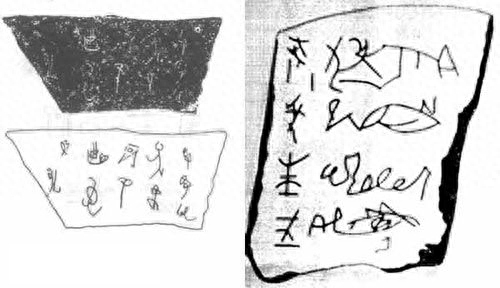
(Tao Wen)
I guess the appearance of pottery inscriptions should be in the clan period of primitive society. At this time, there were no complicated utensils. After the clay was kneaded and fired, it became pottery to hold items. In order to make it beautiful, patterns were added to make it record events. , it became writing, and the so-called pottery writing was formed. Tao inscriptions are authentic ancient writings. Before seals were produced in ancient times, no one before Zhao Zhiqian noticed that these writings could be used for printing, or that they could be used as a reference for seal cutting works. After Zhao Zhiqian, "outside printing" The thought of "Entering Seal" made a big turn, and Tao Wen gradually entered the vision of seal carving creators.
There is currently no good dictionary of pottery inscriptions, or there may be one, such as "Dunyan Ancient Pottery Cun", but there is nowhere to buy it. Therefore, most beginners of seal cutting can only find some sporadic information for reference. This was not the case in India after the Warring States Period.
Oracle:
Oracle bone inscriptions talk about a lot of information, so I won’t go into details here. Everyone remembers that it is the writing on ancient tortoise shells and animal bones. It was unearthed in the Yin Ruins in Anyang, Henan Province during the Guangxu period of the Qing Dynasty. Later, Luo Zhenyu made detailed research and interpretation, and photocopied it in the "Yin Ruins Book Deed Jinghua". But this book is not available for purchase. If conditions permit, beginners of seal cutting can check my official account (Three Little Puddings). There is an article in front of me that lists all the diagrams of Oracle Bone Inscriptions. If conditions permit, you can buy "Oracle Bone Inscriptions Dictionary". Edited by Xu Zhongshu, the price is not expensive, priced at 300 yuan. If there are events, the price may be even lower.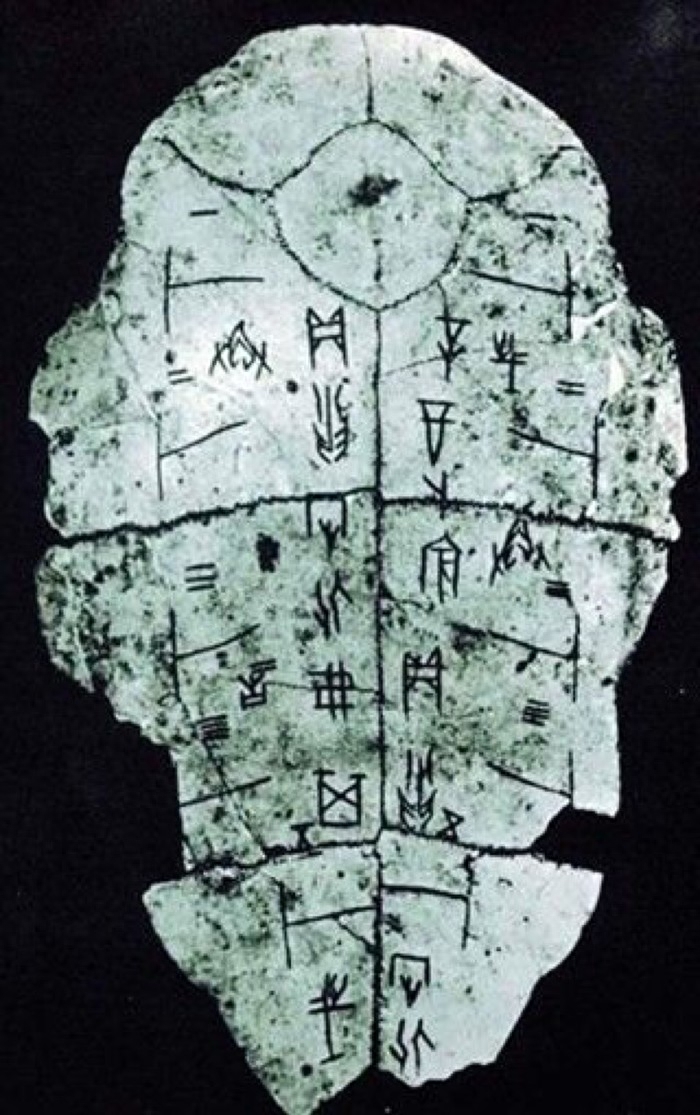
(Oracle)
It is worth mentioning that there are many characters in oracle bone inscriptions. Most of the old words and phrases can be found in oracle bone inscriptions. When creating, there are not many words to combine and split. Therefore, many seal carvers now use oracle bone inscriptions to create their creations. In the contemporary seal world , there are many such seals, and beginners must be careful not to use the Chinese seal format or Yuanzhu style for the composition and the ancient oracle bone script for the text. The form does not match the content.
Big seal script:
This item also includes two major categories: bronze inscriptions and stone drum inscriptions. Shigu inscriptions also have a branch of Zhou inscriptions. Therefore, some beginners are confused here.
Bronze inscriptions refer to the words engraved on bells, tripods, Yi vessels, Quanbu (that is, ancient coins), mirrors, Quan, Liang, and imperial edicts during the Xia, Shang, Zhou, Qin, and Han dynasties, because the materials used to make these things are Bronze ware belongs to metal, so it is called Jinwen. Because there are many bells and tripods, it is also called Zhongdingwen. According to Rong Geng's "Jinwen Bian", there are a total of 3,722 bronze inscriptions, of which 2,420 are identifiable characters. This ready-made reference book is "Jin Wen Bian", which is very good, and the price is about 200 yuan. You can't buy Wu Dahan's "Shuo Wen Gu Zhen Bu" anymore, so grab a copy of "Jin Wen Bian" if you can.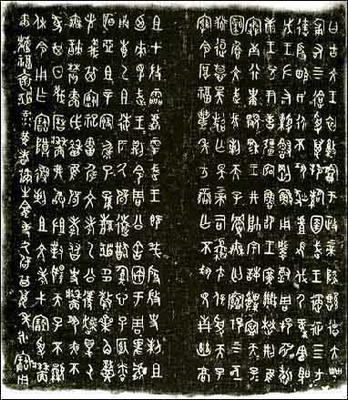
(Bronze Inscriptions)
Stone drum inscriptions are actually also large seal scripts. The difference from bronze inscriptions is that they are engraved on stone drums. Because the materials are different, the structure is of course different. And because large seal scripts are used in seals, it has become a trend now. Therefore, large seal scripts are very valued, and stone drum inscriptions are very popular. And because the characters are carved on stone, they are very similar to the current seal cutting stones, so they are more reference-oriented. Therefore, the Stone Drum Inscriptions are highly valued. In addition, after master Wu Changshuo studied the Stone Drum Inscriptions carefully, the seal carvings are unique and unique. Therefore, the Stone Drum Inscriptions are even more important for seal cutting. Learners attach great importance to it and almost think that Shiguwen is the authentic version of Dazhuan. In fact, if you want to learn Dazhuan, bronze inscriptions cannot be ignored. Fortunately, there were only 718 characters in Shiguwen at the beginning, and even fewer have been preserved, only more than 400 characters. One character a day, almost eliminated in a year.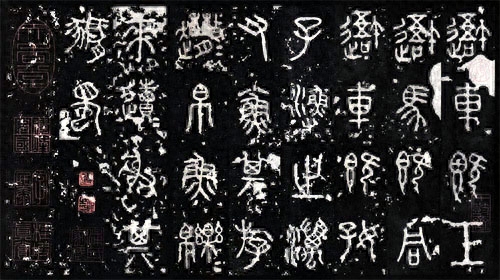
(Shiguwen)
There is a side concept in Shiguwen, which is Zhouwen, which specifically refers to the characters in "Shi Zhoupian" that are different from Xiaozhuan. This character is Shiguwen, but it is only listed specifically, and only 220 characters are listed in "Shuowen Jiezi" , not much. It's not a big problem either.
To check the Shigu text, just look up the copybook directly, no dictionary is needed.
Xiaozhuan:
It is the unified script stipulated by Qin Shihuang after he unified the six kingdoms. This concept has been discussed a lot. I won’t go into more details. Check Xiaozhuan. The Zhonghua Book Company’s version of “Shuowen Jiezi” is the most reliable. There are more than 9,000 words, and all commonly used words can be found in this book.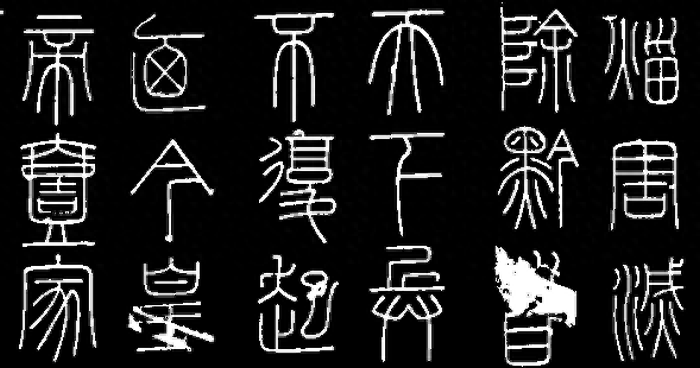
(小篆)
Copy seal script:
Some people say, you have already talked about Xiaozhuan, and you want to introduce imitation seal script. Aren't the two the same thing? In fact, we can only say that this is a character of a dynasty, but not a form of character.
When we look up small seal scripts, they are mostly used to engrave Yuan Zhuwen style seals. When we look up imitation seal scripts, most of the time they are engraving seals in the Qin style. Of course, some seal makers also use the characters in the Qin seal to carve Yuan Zhuwen style seals. I neither agree nor disagree.
The imitation seal script is a special type of writing prescribed by the Qin Dynasty for engraving. Its structure is square and is not exactly the same as the ordinary small seal script. To check the small seal script, we looked up "Shuowen Jiezi" to check the imitation seal script, but we had to go to the Qin Dynasty to check the imitation seal script. Check it out in Yinli.
Chinese seal script:
Some people may also say, isn’t Han seal script the same as Miao seal script? No, the two are different.
Han seal script is a text that exists on the foreheads of stele and a few Han steles (such as "Yuan An Stele") in the Han Dynasty. It is slightly mixed with the official style and is basically similar to the small seal script, but it is not the Miao seal script used for sealing in the Han Dynasty. The Han seal script in "Stele" is basically close to the official script, and it can also be regarded as a reference font for Han seal script, but it is different from Miao seal script. When checking Han seal script, you can check the forehead of a stele or a limited number of stele, so there are not many words, just read them one by one, which can be used as a reference for engraving.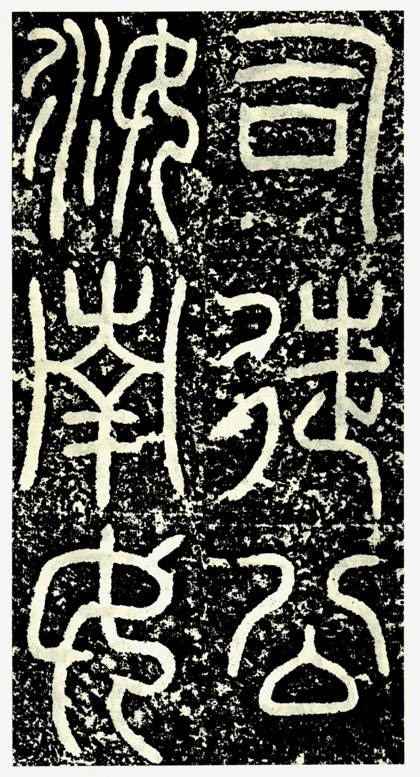
(Han Seal "Yuan An Stele")
Miao Zhuan:
I won’t go into details about this. They are the characters in Han seals, which are specially used for seal cutting. For seal cutting works carved in Han seal style, just check Mu Seal, a set of "Added Chinese Seal Character Symbols" or "New Edition" "Han Seal Dividing Rhymes" can roughly complete the task. The former costs less than 200 yuan, and the latter costs dozens of yuan. They are still on sale and are not difficult to buy. The former seems to be becoming less and less, so hurry up.
Ancient Brick Text:
Although Han seal script is not a popular writing, there are still a lot of Qin Dynasty cultural remnants. Therefore, Han seal script cannot only exist on the forehead of the stele, but also on bricks and tiles. Of course, it also exists on seals. The existing Han Dynasty bricks and tiles are in the Han Dynasty. Or it can be regarded as building materials. Those with written content are basically works of art of cultural relic level. Nowadays, seal cutting people specialize in bricks and tiles, which are very ancient. Beginners of seal cutting can also learn from them, and the form and content of seal cutting can be used. Learn from the Han Dynasty Brick and Tile Text.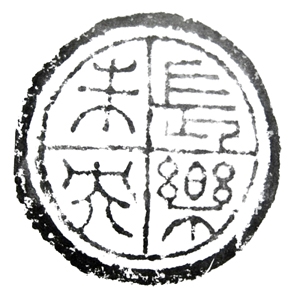
(Wadang characters in Han dynasty wadang rubbings)
There is a book that you can check out, called "Jinshisuo", but I can't find it now. We can only start with sporadic information. Fortunately, beginners are not in a hurry to study brick and tile characters.
Seal text:
It is said that when Zhao Zhiqian saw sealing mud for the first time, he thought it was a seal. Later, people studied it clearly and found that it turned out to be sealing mud. The sealing characters are not different from the seal characters and the seal characters. The three are related. Not much to say about seals. Yin Tao is a pottery made by firing a seal on a made material. Seal mud is an imprint formed by sealing a seal on unfired clay. Seal sealing began in the Shang and Zhou dynasties or even earlier. In the early days, before paper was widely used, seals were mainly used to seal mud, so as you can see, there are many white seals in Han seals.
In fact, sealing mud can be said to be the origin of modern fire seals. It was just rough at that time, but now it is much more refined. Of course, the characters on the seal are slightly different from the characters on the seal. The seal is exquisitely crafted, while the seal is more regular and strict, while the seal is relatively vast and thick, so the characters are not exactly the same.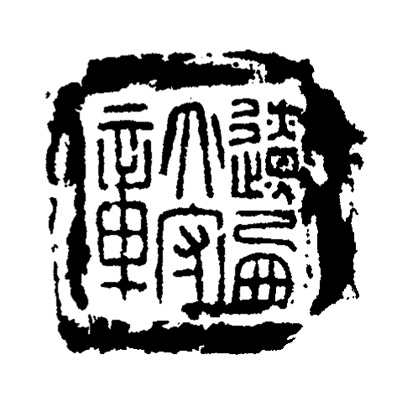
(mud text)
There is a book about Fengni texts called "A Study of Fengni" compiled by Wu Shifen and Chen Jieqi. It seems that it can still be purchased for no more than 100 yuan.
When engraving different seals, roughly use different characters of the same type, and try not to mix characters from different periods. This is neither rigorous nor in line with the laws of art. Of course, when a certain character cannot be found in characters from the same period, You can use the methods of splitting and combining characters to deal with it. However, when there are many combined characters or split characters in a certain font, you should consider whether this type of seal needs to be printed with a different type of text.
([Lao Li Ke Tang] No. 110, some pictures are from the Internet)
Articles are uploaded by users and are for non-commercial browsing only. Posted by: Lomu, please indicate the source: https://www.daogebangong.com/en/articles/detail/xue-zhuan-ke-yao-yong-dao-nei-xie-gu-wen-zi-lei-xing.html

 支付宝扫一扫
支付宝扫一扫 
评论列表(196条)
测试